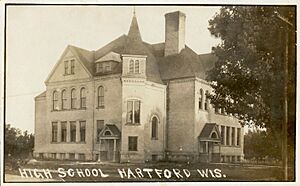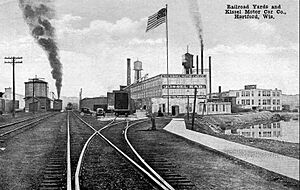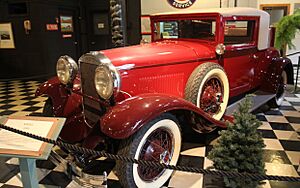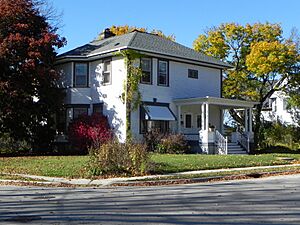Hartford, Wisconsin facts for kids
Quick facts for kids
Hartford, Wisconsin
|
|
|---|---|
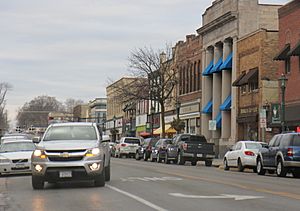
Downtown Hartford on WIS 83
|
|

Location of Hartford in Dodge County (west) and Washington County (east), Wisconsin
|
|
| Country | |
| State | |
| Counties | Dodge, Washington |
| Area | |
| • Total | 8.51 sq mi (22.04 km2) |
| • Land | 8.43 sq mi (21.83 km2) |
| • Water | 0.08 sq mi (0.21 km2) |
| Elevation | 981 ft (299 m) |
| Population
(2010)
|
|
| • Total | 14,223 |
| • Estimate
(2019)
|
15,445 |
| • Density | 1,832.58/sq mi (707.57/km2) |
| Time zone | UTC-6 (Central (CST)) |
| • Summer (DST) | UTC-5 (CDT) |
| ZIP Codes |
53027, 53078, 53086
|
| Area code(s) | 262 |
| FIPS code | 55-33000 |
| GNIS feature ID | 1566104 |
Hartford is a city in Wisconsin, located in both Dodge and Washington counties. In 2020, about 16,000 people lived there. Most of the city's population is in Washington County. The part of the city in Dodge County is mainly for businesses and factories. Hartford is about 38 miles (61 km) northwest of Milwaukee, making it part of the larger Milwaukee area.
Contents
History of Hartford
Early Settlement and Growth
Long ago, in the early 1800s, the Hartford area was home to the Potawatomi and Menominee Native American people. They had a trading post by the Rubicon River and a village near Pike Lake. These groups later gave up their land claims to the U.S. government through treaties in the 1830s. Even so, some Native Americans stayed in the area for a while. Many of them were called "strolling Potawatomi" because they moved around their old lands. Eventually, many Potawatomi moved to northern Wisconsin and formed the Forest County Potawatomi Community.
The first White settler to buy land in Hartford was Timothy Hall in 1843. Soon after, German immigrants John Thiel and Nicolaus Simon saw that the Rubicon River was perfect for a water-powered mill. In 1844, they built a dam and a sawmill with James and George Rossman. This mill used the river's power to cut lumber from the large forests. In 1846, Charles Rossman built a gristmill to process grain.
On January 31, 1846, the area became the Town of Wright. It was renamed the Town of Hartford in February 1847, named after Hartford, Connecticut. Many early settlers were from New England, but some were German immigrants. They cleared land for farms, built roads, and set up a post office. Churches were also built, starting in 1847. Businesses like general stores and equipment dealers opened to support the farming community.
In 1855, the La Crosse and Milwaukee Railroad was built through Hartford. This railroad was important for the town's growth. However, the company failed in 1861, causing problems for local landowners who had invested in it.
The early years also saw some misunderstandings between settlers and Native Americans. For example, in 1861, a rumor spread that a large group of Native Americans was planning an attack. Many men in Hartford armed themselves and went to fight. But when they arrived, they found the story was not true. This event caused fear for both Native Americans and settlers.
Growth and Industry
Hartford officially became a city in 1883. In the late 1800s and early 1900s, Hartford's economy changed. It grew from a small farming town to a bigger industrial center. In 1906, the Kissel Motor Car Company opened. It became the city's biggest employer, creating many jobs and bringing new workers to the area.
Other factories in Hartford included:
- The International Stamping Company, which made car parts.
- The Hartford Canning Company, which processed crops like peas from local farms.
- Knitting mills, a glove factory, tanneries, and a brewery.
During World War II, Hartford's factories helped the war effort. The Kissel car factory, which was sold in 1944, started making things like shell casings and parts for gas masks. The Hartford Canning Company made food for soldiers. In 1944, German prisoners of war were brought to Hartford to help with farm work and in factories due to labor shortages. A building on Jefferson Street was used as a prisoner of war camp for 600 German prisoners. The camp closed in 1946.
Hartford's population grew a lot after World War II. It more than doubled between 1950 and 1960. While many old factories have closed, Hartford still has large manufacturers today. One example is Broan-NuTone, which makes ventilation systems. In 1990, the city expanded its industrial area by adding land from the nearby Town of Rubicon.
Historic Places
Several buildings in Hartford are listed on the National Register of Historic Places. These include some of the homes built by the Kissel family and other houses they constructed.
The Hartford post office has a special painting called Autumn Wisconsin Landscape. It was painted in 1940 by Ethel Spears as part of a government program during the Great Depression to create jobs for artists.
Geography and Climate
Hartford's Location
According to the United States Census Bureau, Hartford covers about 8.02 square miles (20.77 km2) of land and water. The city is located within the Kettle Moraine. This area has unique landforms like kettles (bowl-shaped hollows), lakes, hills, and kames (mounds of sand and gravel). These were all formed by glaciers long ago.
Weather Events
On June 18, 2006, an F1 tornado hit Hartford. It caused minor damage to homes and more serious damage on the south side of the city. Lincoln Elementary School and the Silver Bell Motel had damage to their roofs and structures.
Climate Information
| Climate data for Hartford, Wisconsin (1991–2020 normals, extremes 1897–1901, 1953–present) | |||||||||||||
|---|---|---|---|---|---|---|---|---|---|---|---|---|---|
| Month | Jan | Feb | Mar | Apr | May | Jun | Jul | Aug | Sep | Oct | Nov | Dec | Year |
| Record high °F (°C) | 55 (13) |
69 (21) |
83 (28) |
88 (31) |
94 (34) |
100 (38) |
105 (41) |
101 (38) |
97 (36) |
89 (32) |
75 (24) |
65 (18) |
105 (41) |
| Mean maximum °F (°C) | 45.6 (7.6) |
50.3 (10.2) |
65.0 (18.3) |
77.1 (25.1) |
85.1 (29.5) |
90.4 (32.4) |
91.1 (32.8) |
89.2 (31.8) |
86.9 (30.5) |
79.1 (26.2) |
63.9 (17.7) |
50.2 (10.1) |
93.2 (34.0) |
| Mean daily maximum °F (°C) | 25.9 (−3.4) |
29.9 (−1.2) |
41.3 (5.2) |
54.3 (12.4) |
66.7 (19.3) |
76.6 (24.8) |
80.2 (26.8) |
78.6 (25.9) |
71.8 (22.1) |
58.7 (14.8) |
43.8 (6.6) |
31.3 (−0.4) |
54.9 (12.7) |
| Daily mean °F (°C) | 17.2 (−8.2) |
20.7 (−6.3) |
31.5 (−0.3) |
43.7 (6.5) |
55.5 (13.1) |
65.5 (18.6) |
69.2 (20.7) |
67.4 (19.7) |
60.1 (15.6) |
47.9 (8.8) |
34.8 (1.6) |
23.3 (−4.8) |
44.7 (7.1) |
| Mean daily minimum °F (°C) | 8.5 (−13.1) |
11.4 (−11.4) |
21.7 (−5.7) |
33.2 (0.7) |
44.3 (6.8) |
54.4 (12.4) |
58.2 (14.6) |
56.2 (13.4) |
48.4 (9.1) |
37.1 (2.8) |
25.9 (−3.4) |
15.4 (−9.2) |
34.6 (1.4) |
| Mean minimum °F (°C) | −13.9 (−25.5) |
−9.2 (−22.9) |
1.5 (−16.9) |
20.5 (−6.4) |
31.1 (−0.5) |
41.5 (5.3) |
48.1 (8.9) |
45.3 (7.4) |
34.2 (1.2) |
23.7 (−4.6) |
10.9 (−11.7) |
−4.5 (−20.3) |
−18.3 (−27.9) |
| Record low °F (°C) | −35 (−37) |
−34 (−37) |
−23 (−31) |
1 (−17) |
20 (−7) |
31 (−1) |
39 (4) |
36 (2) |
23 (−5) |
9 (−13) |
−11 (−24) |
−29 (−34) |
−35 (−37) |
| Average precipitation inches (mm) | 1.52 (39) |
1.26 (32) |
1.78 (45) |
3.43 (87) |
3.82 (97) |
4.77 (121) |
3.89 (99) |
3.74 (95) |
3.23 (82) |
2.91 (74) |
2.06 (52) |
1.68 (43) |
34.09 (866) |
| Average snowfall inches (cm) | 10.0 (25) |
9.1 (23) |
4.0 (10) |
1.4 (3.6) |
0.3 (0.76) |
0.0 (0.0) |
0.0 (0.0) |
0.0 (0.0) |
0.0 (0.0) |
0.3 (0.76) |
1.1 (2.8) |
10.1 (26) |
36.3 (92) |
| Average precipitation days (≥ 0.01 in) | 9.7 | 8.4 | 8.2 | 10.7 | 12.0 | 10.9 | 9.0 | 9.2 | 8.7 | 10.0 | 8.5 | 9.2 | 114.5 |
| Average snowy days (≥ 0.1 in) | 6.2 | 5.4 | 2.7 | 0.6 | 0.0 | 0.0 | 0.0 | 0.0 | 0.0 | 0.1 | 1.0 | 4.8 | 20.8 |
| Source: NOAA | |||||||||||||
Transportation
The Hartford Municipal Airport serves Hartford and nearby communities. An air ambulance service, which helps transport sick or injured people by air, has been operating at the airport since 2021.
Population and People
| Historical population | |||
|---|---|---|---|
| Census | Pop. | %± | |
| 1880 | 1,343 | — | |
| 1890 | 1,296 | −3.5% | |
| 1900 | 1,632 | 25.9% | |
| 1910 | 2,982 | 82.7% | |
| 1920 | 4,515 | 51.4% | |
| 1930 | 3,754 | −16.9% | |
| 1940 | 3,910 | 4.2% | |
| 1950 | 2,549 | −34.8% | |
| 1960 | 5,627 | 120.8% | |
| 1970 | 6,499 | 15.5% | |
| 1980 | 7,159 | 10.2% | |
| 1990 | 8,188 | 14.4% | |
| 2000 | 10,978 | 34.1% | |
| 2010 | 14,223 | 29.6% | |
| 2019 (est.) | 15,445 | 8.6% | |
| U.S. Decennial Census | |||
Hartford's Population in 2010
In 2010, Hartford had 14,223 people living in 5,685 households. About 35% of households had children under 18. The average age in the city was 35.6 years old. About 26.5% of residents were under 18. The population was 49.1% male and 50.9% female.
Most of the people in Hartford were White (94.7%). Other groups included African American (0.9%), Native American (0.5%), and Asian (0.8%). About 4.8% of the population identified as Hispanic or Latino.
Economy and Businesses
Hartford was once a major center for car manufacturing, especially with the Kissel Motor Car Company before 1926. Over the years, other large companies like a Chrysler Marine engine plant and a Libby's beet processing plant were here. Today, Hartford is home to many smaller industries. It is also the main office and a factory location for Broan-NuTone, which makes ventilation systems.
The Kissel Family and Their Businesses
In 1883, Ludwig "Louis" Kissel moved to Hartford. By 1890, he and his four sons (Adolph P., Otto P., William L., and George A.) started many businesses. They began with the L. Kissel & Sons Hardware store. They also had the Hartford Plow Works, which made farm machinery. The Kissels even developed their own gasoline engines, including a boat motor for Sears and Roebuck. Other businesses included the Hartford Electric Company, a stone quarry, and a sand pit.
In 1906, Louis and his sons started the Kissel Motor Car Company. This company began making cars in 1907 and continued until 1930. The Kissel family was also involved in banking. Otto Kissel helped form the First National Bank of Hartford in 1906 and later became its president. In 1923, the Hartford Chamber of Commerce was created, with Otto Kissel as a founding member. After the car company closed, Kissel Industries was formed in 1936. They used the old factory to make the Kissel outboard motor, which was sold by Sears and Roebuck until 1944.
Education in Hartford
The School District of Hartford provides public education for elementary students. Lincoln and Rossman Elementary Schools teach students from kindergarten to fifth grade. After elementary school, all Hartford students go to Central Middle School for grades 6 through 8.
For high school, students attend Hartford Union High School (HUHS). This high school is separate from the elementary and middle school district. It has about 1500 students. HUHS serves students from the city of Hartford, the Town of Hartford, and nearby communities like Richfield, Erin, Friess Lake, and Neosho.
There are also several private schools in Hartford, such as St. Kilian Roman Catholic School and Peace Lutheran. The city's public library is called the Jack Russell Memorial Library.
Things to Know About Hartford
- The city has grown by adding parts of the Town of Hartford and other areas, including Pike Lake. The Pike Lake Unit of the Kettle Moraine State Forest is located on the lake.
- Hartford has a large industrial park on its edge. This park includes a Quad Graphics factory, which employs many people from the city.
- The Schauer Arts Center is a regional arts center in Hartford. It hosts professional performances, offers art classes for all ages, and holds social events.
- Hartford is the closest city to Erin Hills, a public golf course. This course hosted the 2017 United States Open golf tournament.
Notable People from Hartford
- The Amagi, YouTuber
- Samuel S. Barney, Justice of the U.S. Court of Claims and Congressman
- Alfred G. Becker, Wisconsin State Representative
- John R. Bohan, Wisconsin State Senator
- Hopewell Coxe, Wisconsin State Representative
- Steve Feak, game designer at Riot Games
- Edward J. Gehl, Wisconsin Supreme Court justice
- Dennis Hall, Olympic wrestler
- Curt Hansen, actor, singer
- Polly Koch, professional football player
- Michael A. Lehman, Wisconsin State Representative
- Quinn Meinerz, NFL football player
- John A. Norman, Wisconsin State Representative
- Jesse Peters, Wisconsin State Senator
- Jacob C. Place, Wisconsin State Representative
- Adam F. Poltl, Wisconsin State Representative and Mayor of Hartford
- Don Pridemore, legislator
- John Reiser, former general manager of Roush Racing NASCAR Busch Series and Craftsman Truck Series race shops
- Adam Schantz, Wisconsin State Senator
- Ronald A. Sell, Wisconsin State Representative
- John Shinners, NFL player
- Jeremy Unertl, professional football player
- Ericka Walker, artist
- George Weissleder, Wisconsin State Senator
See also
 In Spanish: Hartford (Wisconsin) para niños
In Spanish: Hartford (Wisconsin) para niños


